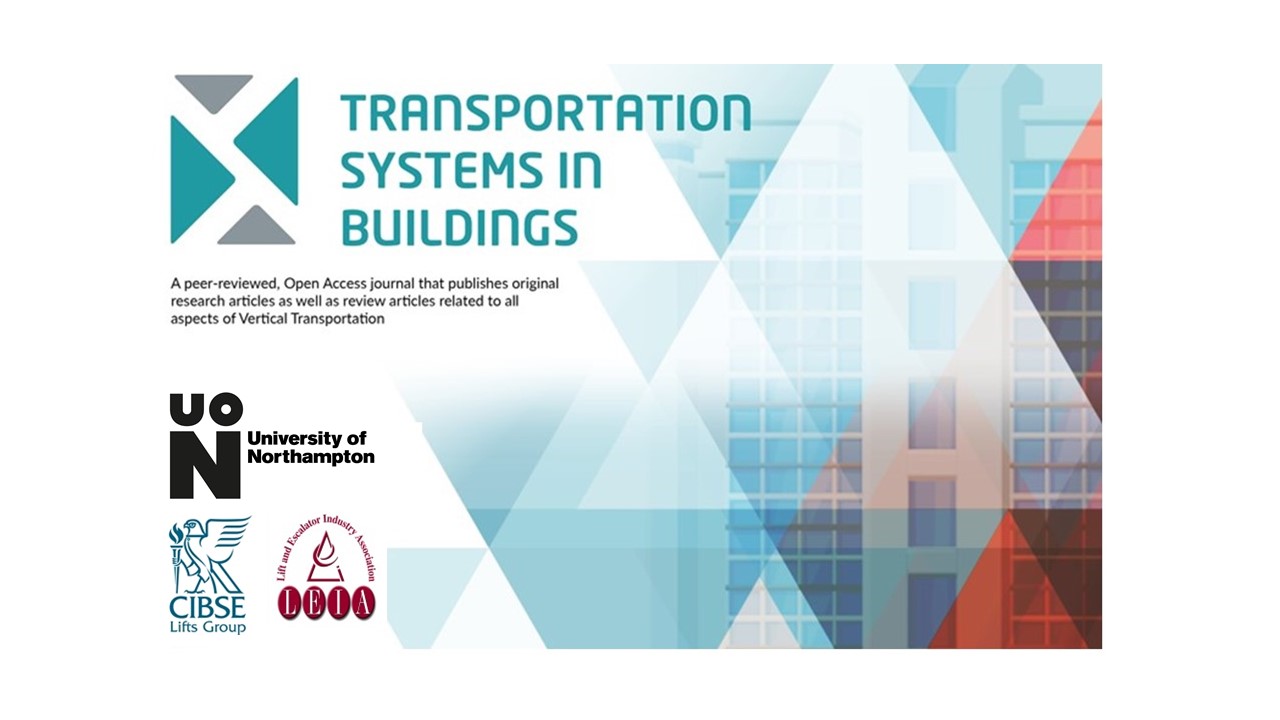Departure Delays in Lift Systems
DOI:
https://doi.org/10.14234/tsib.v2i1.146Abstract
There is a range of lift systems with more than one car or cabin per shaft. Double deck lifts have a car with two attached cabins, serving adjacent floors at the same time. Other systems enable two independent cars to share the same shaft. The next generation ropeless lifts will allow many cars to share the same shafts.
In these systems, the interaction between the cars and cabins affects the quality of service for passengers. Departure delays occur when passenger loading and unloading times or the sequence of stops required to serve passengers is not the same. The consequence is that cars and cabins delay each other’s departure. Departure delays can also occur in lift systems with a single car and cabin per shaft, for example when destination calls are registered at a significant walking distance from the lift lobby.
To include departure delay in an assessment of quality of service, definitions of passenger and cabin departure delays, and a method to measure these delays are required. This paper describes the different types of departure delays and their causes. This provides metrics which can be applied in lift planning and dispatcher design.
References
CIBSE (2015) CIBSE Guide D: 2015 Transportation systems in buildings. London: The Chartered Institution of Building Services Engineers.
Thumm, G. (2004) A breakthrough in lift handling capacity. In: Elevator Technology 14, Proceedings of Elevcon 2004. The International Association of Elevator Engineers.
ThyssenKrupp Elevator AG (2014) New era of elevators to revolutionize high-rise and mid-rise construction [online]. Available from: http://www.urban-hub.com/ideas/new-era-of-elevators-to-revolutionize-high-rise-and-mid-rise-construction/ [Accessed 04/20, 2015].
Smith, R. and Gerstenmeyer, S. (2013) A review of Waiting Time, Journey Time and Quality of Service. In: Symposium on Lift and Escalator Technologies. Northampton: The Lift and Escalator Symposium Educational Trust.
Smith, R. and Peters, R. (2004) Enhancements to the ETD Dispatcher Algorithm. In: Elevator Technology 14, Proceedings of Elevcon 2004. The International Association of Elevator Engineers.
Tanaka, S. and Watanabe, M. (2009) Optimization-based collision avoidance in multi-car elevator systems. In: ICCAS-SICE, 2009.
Gerstenmeyer, S. and Peters, R. (2016) Multicar dispatching. In: Symposium on Lift and Escalator Technologies. Northampton: The Lift and Escalator Symposium Educational Trust.
Barney, G. (2003) Elevator Traffic Handbook. London: Spoon Press.
https://doi.org/10.4324/9780203301333
Strakosch, G. and Caporale, R. (2010) The Vertical Transportation Handbook, Fourth Edition. Hoboken; New Jersey: John Wiley & Sons, Inc.
https://doi.org/10.1002/9780470949818
Maister, D. (1985) The Psychology of Waiting Lines [online]. Available from: http://davidmaister.com/articles/the-psychology-of-waiting-lines/ [Accessed 02/12, 2014].
Fortune, J. (1995) Modern double deck elevator applications and theory. In: Elevator Technology 6, Proceedings of Elevcon 1995. The International Association of Elevator Engineers.
Norman, D. (2008) The Psychology of Waiting Lines [online]. Available from: http://www.jnd.org/dn.mss/the_psychology_of_waiting_lines.html [Accessed 05/07, 2014].
Peters, R. (2012) Lift Performance Time. In: Symposium on Lift and Escalator Technologies. Northampton: The Lift and Escalator Symposium Educational Trust.
Powell, Bruce. (bruce.powell@comcast.net) 2015. TWIN simulation. e-Mail to S. Gerstenmeyer (Stefan.Gerstenmeyer@thyssenkrupp.com, 07.07.2016)
Bird, C., Peters, R., Evans, E. and Gerstenmeyer, S. (2016) Your Lift Journey – How Long Will You Wait? In: Symposium on Lift and Escalator Technologies. Northampton: The Lift and Escalator Symposium Educational Trust.
Sorsa, J. and Siikonen, M. (2006) Double-deck destination control system. In: Elevator Technology 16, Proceedings of Elevcon 2006. The International Association of Elevator Engineers.
Müller, J. (2014) Lift Systems in High-Rise Buildings: Handling Capacity and Energy Efficiency. In: Symposium on Lift and Escalator Technologies. Northampton: The Lift and Escalator Symposium Educational Trust.
Gerstenmeyer, S. and Peters, R. (2015) Lifts without ropes: how many shafts and cars are needed? In: Symposium on Lift and Escalator Technologies. Northampton: The Lift and Escalator Symposium Educational Trust.
Downloads
Published
How to Cite
Issue
Section
License
The author(s) must warrant that an article is original and the sole work of the author(s); the author(s) must also obtain relevant permissions from any third-party copyright holders. Where an article or report has more than one author, the submitting author is responsible for ensuring that all other authors agree to the terms of submission.
Copyright and associated moral rights in works published in Transportation Systems in Buildings are retained by the authors. Authors grant to The University of Northampton and Transportation Systems in Buildings non-exclusive rights to reproduce works electronically (in full or in part) and to publish works in any such media current or later developed. By virtue of their appearance in this open access journal, works may be used freely, with proper attribution, in educational and other non-commercial settings.

